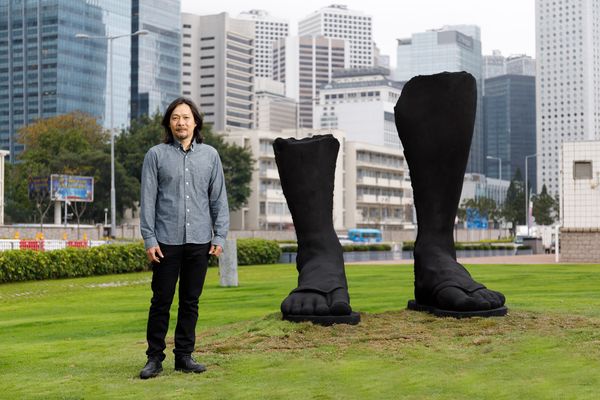Installation view of Before Collapse, 2018, with artist Matthew Tsang Man Fu. © Harbour Arts Sculpture Park
Phillips is honored to be a major partner of Harbour Arts Sculpture Park, the first international outdoor exhibition of sculpture in Hong Kong, held at a time when the city plays host to Art Basel and an exciting line-up of arts events. This sponsorship builds on our commitment to supporting preeminent, contemporary institutions and projects through a worldwide program of Arts Partnerships.
Curated by Fumio Nanjo, Director of Mori Art Museum and Director of International Programmes at Hong Kong Art School, and Tim Marlow, Artistic Director at the Royal Academy of Arts, this public sculpture park fosters a unique opportunity to experience world-class art by a dynamic selection of 19 local and international contemporary artists, both emerging and renowned, set against the backdrop of Hong Kong's iconic skyline.
As anticipation builds and visitors travel to the city for Art Basel Hong Kong and a myriad of other events and special exhibitions, Jonathan Crockett, Head of 20th Century & Contemporary Art and Deputy Chairman, Asia, spoke to co-curator Fumio Nanjo about this invigorating new initiative.
Jonathan Crockett: How did you originally hear about this project and what was your response to becoming involved as a curator?
Fumio Nanjo: This project is a very important initiative for Hong Kong since the harbourfront is one of the best locations for Hong Kong residents and visitors to enjoy a collection of international artworks. I hope this new venture will be the first of many for Hong Kong Arts Centre and that we continue to enrich the livelihood of all of Hong Kong's citizens, with support from the HKSAR Government.
JC: What was the central theme that the sculpture park, featuring 19 local and international artists, was curated around?
FN: The theme of Harbour Arts Sculpture Park is "Art is for everyone". Over 50 artists, galleries and sponsors have come together to give Hong Kong and its visitors a unique opportunity to experience world-class art set against the backdrop of Hong Kong's skyline, free of charge.
The project is accompanied by an education program with an aim to encourage discussion of art in the city and create a culturally vibrant Hong Kong through the appreciation and learning of arts and culture, as well as to enhance the accessibility of arts at every level of the community.
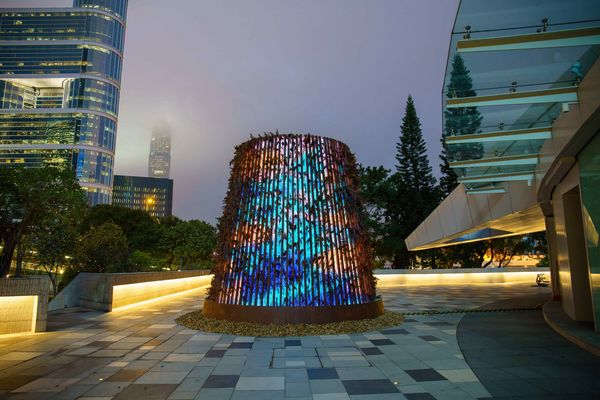
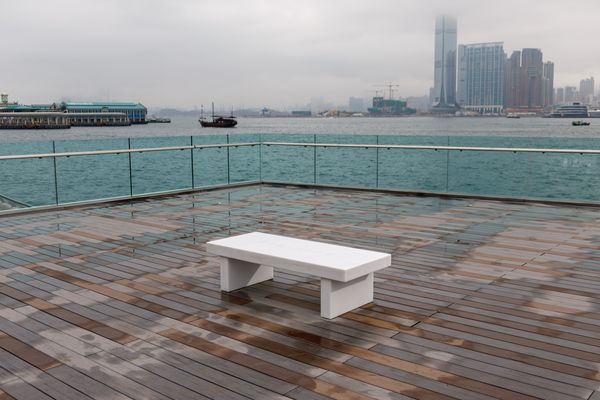
Installation views of Wong Chi-Yung The Memories from The Tower of Light, 2017 (above) and Jenny Holzer Truisms, 2013 (below). © Harbour Arts Sculpture Park
JC: How important was it to you and co-curator Tim Marlow to showcase local contemporary artists alongside those from abroad? And emerging names alongside firmly established ones?
FN: It was very important to us. We wanted to ensure we embraced the talented local artists in Hong Kong and introduced international names from abroad. Harbour Arts Sculpture Park is about encouraging discussion of art in the city and promoting public interaction that cannot happen without cultivating the Hong Kong art scene and nurturing our talents. It was crucial to get the local artists on board with this project and hope that similar projects will bloom in the future.
JC: Can you describe the variety of media and materials that comprise the works on view?
FN: I think you should pay attention to such materials as the stainless steel, fiberglass and rusted steel. Since the project is outdoors, all material needed to be durable and kept in good condition. For example, if paint is involved to color any work, it needed to be able to withstand the different weather conditions we experience in Hong Kong.
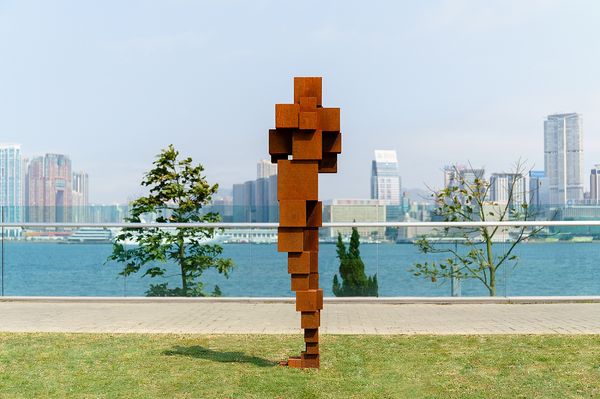

Installation views of Antony Gormley Daze VI, 2016 (above) and Zhan Wang 45 Degrees Artificial Rock, 2014 (below). © Harbour Arts Sculpture Park
JC: Outside of this sculpture park, you work as Director of Mori Art Museum and Director of International Programmes at Hong Kong Arts School. How did this challenge differ from your work with those programs? What experiences from the museum and school did you bring to your work on the Harbour Arts Sculpture Park?
FN: My experience for public art is not limited to the museum practice and teaching experience. I used to direct many public art projects in Japan such as the Shinjuku Island project with international artists such as Sol LeWitt, Roy Lichtenstein, Danielle Buren and Julio Paolini, among others. I have also worked with younger artists with the Yokohama Kamiooka station project; this included Tsuyoshi Ozawa, Nara Yoshitomo and Takashi Murakami.
Every project is very different in terms of space and location. What's interesting is seeing how artists use these experiences to showcase a wide range of vision and assumption to fit into the different spaces. Sometimes it is about colors and forms, but other times it is about the feasibility of technical difficulties.
JC: Since public engagement is a core aspect of this show, how do you hope to activate the local community around it?
FN: Firstly, I hope many people enjoy the works and the view in their daily lives. The view is spectacular and the caliber of art matches it.
In addition, Harbour Arts Sculpture Park is accompanied by the 'Harbour Arts Sculpture Park' Jockey Club Arts Education Programme — an engaging and extensive program of free workshops, educational activities, support tools, interactive guided tours and a public art symposium. We hope members of the community will sign up for different programs and even sign up for the free app — this really is a museum without walls.
Hong Kong's character has always been that it is an international city. Its strength is its ability to be global and diverse.
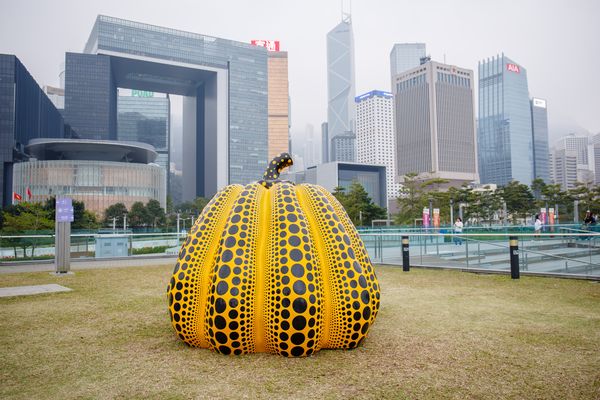
Installation view of Yayoi Kusama Pumpkin: big, 2008. © Harbour Arts Sculpture Park
JC: How do you foresee the future of Hong Kong as a growing international center for contemporary art and unique curation?
FN: Hong Kong's art scene is growing and becoming very strong not only in Asia but also internationally. You can see this project as a learning tool for public art. That's where the biggest impact is. In a sense, Hong Kong will become a showcase of many artistic activities. Organizers should be aware that whatever you do in this city is an important message to the international audience.
Today, though not always the case in politics, I think real globalism is very important for art and culture. It does not mean denying local culture, but acknowledging and respecting all kinds of different local cultures. Only that way will globalism become enriched.
Hong Kong's character has always been that it is an international city. Its strength is its ability to be global and diverse. I personally believe that being an international center of art is a unique and peaceful tool for Hong Kong to establish its identity.
